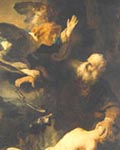

|
Angelology
has never become a systematized branch of Jewish theology nor has it
acquired the pictorial imagery of wings and halos popular in Christian
art. Nonetheless, angels, conceived of as supernatural, celestial beings,
did play a role in Jewish thought and literature from earliest biblical
times. Later, under the influence of the mystics, angels took on new
and complex mythologies involving good versus evil. In modern times,
angels have largely lost their supernatural status, becoming merely
poetic symbols or metaphors.
|
|
|
|
Gustav
Dore, 19th century.
Jacob wrestling with the angel.
(Genesis 32:24)
|
|
In the Bible,
various names are applied to angelic beings. Like the Greek word angelos,
meaning messenger, the term malakh signifies a messenger, either human
or divine. As angels assumed a more prominent role in Jewish thought and lore,
they came to imply only divine messengers.
Throughout
the Bible (except in the prophetic books of Ezekiel, Zechariah, and Daniel),
angels are symbolic extensions of God's power; they possess no independent
life, personality or identity of their own, no personal name and no hierarchical
rank. Thus angels are referred to as bnei elohim or bnei elim
(children of God or gods);[1] kedoshim
or hayyot hakodesh (holy beings);[2]
and as `ir (watcher, envoy).[3] The
famous angels who visit Abraham and Sarah and predict the birth of Isaac and
the imminent destruction of Sodom and Gomorrah, as well as the angel who wrestles
with Jacob, are referred to as simply ish (man).[4]
In the earlier
narratives in particular, they appear as human beings, but also completely
obedient to the divine will. The behavior of these angels is prophetic, usually
beneficent and sometimes punitive; although they may disappear without warning,
they are not characterized as supernatural or immaterial, unlike the creatures
described by the later prophets.
Thus the
angels come to the aid of Hagar, inform Abraham that a son will be born to
him, guard the Israelites against the pursuing Egyptians, protect them during
their wanderings in the wilderness, and interpret the visions of Zechariah
and Daniel. Yet they also destroy Sodom and Gomorrah, punish the citizens
of Jerusalem, and smite the camp of Assyria.[5]
The biblical angels also have celestial duties. In heaven the angels surround
God's throne and form His council and court.[6]
Depending on the nature of their mission, the angel may be referred to as
"the angel which has redeemed"[7]
or "the angel that has destroyed."[8]
In the writings
of the prophets the angels take on a more supernatural role. Angels constitute
the celestial choir that has sung unceasing praise to the Creator since the
beginning of time.[9] The creatures connected
with the divine throne or chariot spoken of by the prophets are assigned such
distinctive names as: seraphim;[10]
keruvim (cherubim);[11]
hayyot (living creatures);[12]
ofannim (wheels).[13]
The Babylonian exile
had a marked effect on Jewish angelology. We read in the Talmud: "The
names of the angels were brought by the Jews from Babylonia."[14]
The angels suddenly become individualized; they are given specific names,
and are ranked, much like Babylonian spirits. Ezekiel speaks of seven angels,
six of whom wrought destruction, while the seventh acted as a scribe. The
man whom Zechariah sees "riding upon a red horse" is described
as the chief of those who "walk to and fro through the earth."[15]
This process reaches its climax in the Book of Daniel, where the angels
are clearly ranked and classified; two high-ranking angels have personal
names (Michael and Gabriel), and national
guardian angels (sarim) are introduced for the first time.[16]


Rembrandt, 1635.
The angel stops Abraham
from sacrificing Isaac
(Genesis 22:11) |
|
|
The concept of rebellious
angels belongs to postbiblical Jewish literature.
|
[1]
Genesis 6:4; 29:1 [back]
[2] Psalms 89:6; 89:8 [back]
[3] Deut. 4:10; 4:14 [back]
[4] Genesis 18-19; 32:25-33; The angels who visit Abraham
and Sarah are also referred to as malakhim. [back]
[5] Genesis 19; Ezekiel 9; II Kings 19:35 [back]
[6] I Kings 22:19 [back]
[7] Genesis 48:16 [back]
|
[8]
II Samuel 24:16 [back]
[9] Job 38:7 [back]
[10] Isaiah 6:2 [back]
[11] Ezekiel 10:3; Genesis 3:24 [back]
[12] Ezekiel 1:5 [back]
[13] Ezekiel 1:15 [back]
[14] JT Rosh Hashanah, 1:2 [back]
[15] Zechariah 1 [back]
[16] Daniel chs. 8 and 10 [back] |
|
James
D. Newsome, Jr., The Hebrew Prophets (Atlanta: John Knox Press,
1973)
Ellen Frankel and Betsy Platkin Teutsch, eds., The Encyclopedia of
Jewish Symbols (New Jersey: Jason Aronson Inc.,1992)
R.J. Zwi Werblowsky and Geoffrey Wigoder, eds., The Oxford Dictionary
of the Jewish Religion (New York and Oxford: Oxford University Press,
1997 |
ANGELS
Table of Contents